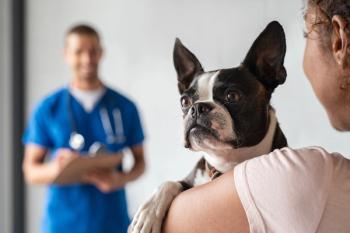
Dental care from top to bottom
Remember, most clients won't appreciate the seriousness of periodontal isease until they see it.
What's the No. 1 disease seen in general veterinary practice? What's the most underdiagnosed and undertreated disease seen in veterinary medicine? The answer to both questions is periodontal disease. Periodontal disease affects nearly 80% of all dogs and cats older than 3, according to the American Veterinary Dental Society. Yet only about 3% of affected dogs and 1% of affected cats receive proper dental care, according to the 2003 AAHA Compliance Study. How can you fight these trends and ensure your patients receive the care they need? To help answer this question, let's take a look at the parts, procedures, and people that make up a successful veterinary dental program.
Ernest E. Ward Jr., DVM
The parts
Perhaps the easiest aspect of developing a successful dental program is assembling the equipment you'll need. The basic ingredients include diagnostic equipment and supplies, operatory tools, patient anesthesia and monitoring equipment, and well-trained staff members.
Diagnostic equipment
In the exam room you'll need an illuminating device to show clients those decaying fourth upper premolars. This can be a simple halogen pen light or a more sophisticated transillumination device. To reinforce your message, use a lighted projectable videoscope to show owners images of their pets' teeth and gums. A plaque-disclosing agent can also prove that even the cleanest-looking teeth may hide a dirty secret. Remember, most clients won't appreciate the seriousness of periodontal disease until they see it. Don't be afraid to lift the lips and reveal the disease that's easily ignored yet affecting most of our patients.
Creating the dental experience
Once you've shown the client the damage above and below the gum line, take a look at where the real harm takes place-the tooth roots. Dental radiography is a relatively inexpensive service we often overlook in busy general practice. With just a few thousand dollars, the proper safety equipment, and some simple training, you can generate a new revenue stream in no time.
People are accustomed to having their teeth radiographed when their teeth are cleaned, so it's easy to apply this same rule to pets for every routine dental prophylaxis. Radiographs will help you discover damage you didn't detect during the exam. Use a portable viewing box and "hot-spot" light to review dental radiographs with clients.
Basic dental operatory equipment
You have almost limitless choices for dental scaling and polishing equipment. Choose a system that meets your needs and budget and allows you to expand as your dental skills improve. I recommend adjustable-speed handpieces for polishing, drilling and burring, or cutting. When working on that fourth upper premolar or canine tooth, you'll want contra angles, which are specifically designed for this application. Don't forget basic burs and cutting discs. You may need to replace these pieces often, so you don't get caught with a dull bur. You'll also need an assortment of probes and explorers, so pick up a basic pack. Too often we forget to use an autoclave to sterilize dental equipment between patients. So when you schedule dental appointments, factor in time to sterilize your equipment. This has only recently become an American Animal Hospital Association accreditation standard. Finally, a magnifying loupe and a good light source will help with the detailed work you'll perform.
Dental facts your team should know
A digital camera lets you document any notable lesions or abnormalities and share before-and-after pictures with your clients-they love to see the dramatic improvement in their pet's smile and may want copies. I also recommend providing digital copies of the pet's dental radiographs. Simply photograph the radiographs with a digital camera, edit the images in a software program, and print the pictures. This value-added service will reinforce your diagnosis and treatment and help build word-of-mouth recommendations.
Anesthesia and monitoring equipment
Perhaps clients' biggest concern about dental care is anesthesia. It seems as if everyone has a horror story. While it's true that any anesthetic procedure includes serious risk, you can help allay those fears by reviewing your monitoring equipment and dental protocols with each client to reassure them about the safeguards you take.
To start, critically review your dental anesthetic protocol. With injectable anesthetics, such as propofol, and inhalant agents, such as isoflurane and sevoflurane, you can tailor the safest anesthetic protocol based on the patient's needs. You'll look closely at the pet's temperament, physical condition, preexisting medical conditions, and past anesthetic experiences.
Tips for raising dental awareness
In my practice, we require preanesthetic blood tests for all patients before they undergo dental scaling and polishing, and we provide intravenous catheterization and fluid support throughout the procedure. Ideally, you'll monitor the pet's condition with pulse oximetry, a heart and respiratory rate monitor, electrocardiography, and body temperature measurements. End-tidal CO2 monitoring or a rectal probe for pulse oximetry is also beneficial in dental patients because it can be challenging to obtain consistent pulse oximeter readings using lingual probes during oral procedures.
The people and the process
Even with all of the latest technology, some clients won't be convinced to schedule dental prophylaxis for their pets.This part is up to you and your staff members. Start by developing a uniform message for enthusiastic staff members. Ask yourself why dentistry is important for patients. Research in both people and pets proves that good oral care extends life expectancy, prevents secondary diseases, and improves quality of life.
For example, a University of Minnesota School of Public Health study found that tooth loss caused by gum disease may be an early warning sign of cardiovascular disease.1 Studies by the American Heart Association (
Your team members must be on board with the program also. So train your staff members, make sure they're providing home dental care for their pets, and then allow them to educate your clients. A message from the heart and borne of experience will resonate more deeply with clients, and they will be more likely to comply with your recommendations. Once you're convinced that dentistry is right for you and your team, it's time to get to work.
The first step is to educate yourself. Review the current scientific literature about basic veterinary dentistry,2,3 and identify the areas you want to pursue. Start with the simple procedures and work your way up. Consider taking advantage of some of the outstanding continuing education opportunities offered for veterinary dentistry. For example, the Academy of Veterinary Dentistry Web site (
Next, develop educational materials for staff members and clients. I also recommend encouraging staff members to pursue training through many of the online or home-study dental technician programs (
Finally, make sure each client hears and understands your dental message. The key is to lift the lip of every patient during every visit and make recommendations every time. Use patient questionnaires that target oral health during routine exams to ensure staff members discuss dental care at every visit. (See "Creating the dental experience") Be sure to document the stage of periodontal disease and any abnormalities along with your dental care recommendations on each exam or discharge report. Consistency creates credibility, so if you emphasize dentistry during one visit and ignore it the next, you're sending a mixed message. Don't take rejection personally and vow not to discuss dentistry with the client again. It may take several visits before clients accept your recommendations.
Home dental care
Plaque begins accumulating on the teeth in as little as six hours after a dental scaling and polishing. To help prevent plaque and calculus formation after a dental prophylaxis,encourage pet owners to consider an assortment of innovative and effective home care products. For example, OraVet? gel (Merial) is a product initially applied immediately after a dental prophylaxis at the veterinary hospital. This invisible barrier prevents the bacteria that cause plaque from attaching to the tooth surface, reducing plaque and calculus formation. Clients can then reapply the product at home once a week. This is a great alternative to brushing.
Let's face it: Few veterinarians, much less clients, brush their pets' teeth every day. While I mention daily brushing to my clients, I admit that I don't brush my pets' teeth daily. In fact, since I don't, my pets undergo dental prophylaxis at least once a year. I don't expect my clients to do something that I don't do. Once-a-week application of OraVet is more manageable, even for someone as busy as a veterinarian. Several gels, rinses, and treats are also available to help keep pets' mouths healthy and fresh. (To learn more about veterinary dental products, see "New oral health care products")
We also recommend diets proved to reduce calculus to every client. These diets have tremendously improved pets' well-being, and we're professionally obligated to inform clients that diets can help fight plaque and calculus and provide optimal nutrition for their pets' life stage.
The true secret to a successful dental program is perseverance. We're advocates for our patients; we don't give up the fight at the first sign of trouble. Dental care is one of the most underutilized and underserved opportunities in veterinary medicine. It's also one of our biggest growth opportunities. As the pet population ages and competition for clients escalates, the deciding factor will be not only the number of patients you see, but the number of times a year you see patients and the quality of medicine you provide.
Remember, building a successful dental program isn't just about making money; it's about giving your patients the highest quality care. When you take the time to teach clients about the dangers of periodontal disease, the result is happier, healthier patients.
References
1. Joshipura, K.J.
et al.
: Periodontal disease, tooth loss, and incidence of ischemic stroke.
Stroke 34
(1):47-52, 2003.
2. Bellows, J.: Small Animal Dental Equipment, Materials, and Techniques: A Primer. Blackwell Publishing, Malden, Mass., 2004.
3. Holstrom, S.E. et al.: Veterinary Dental Techniques for the Small Animal Practitioner. W.B. Saunders, Philadelphia, Pa., 1992.
Ernest E. Ward Jr., DVM, is the chief of staff at Seaside Animal Care in Calabash, N.C., and owner of the consulting firm, E³ Management. Dr. Ward is the author of Creating the Veterinary Experience (E³ Management, 2000). He is a frequent speaker and a Veterinary Economics Editorial Advisory Board member.
Newsletter
From exam room tips to practice management insights, get trusted veterinary news delivered straight to your inbox—subscribe to dvm360.






